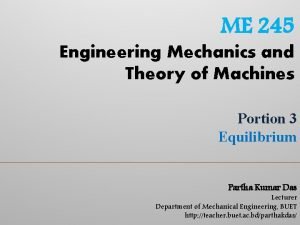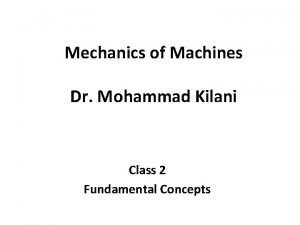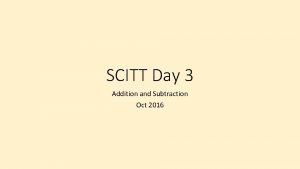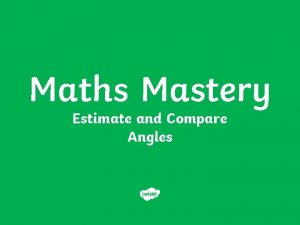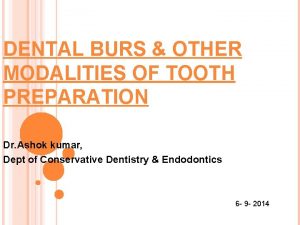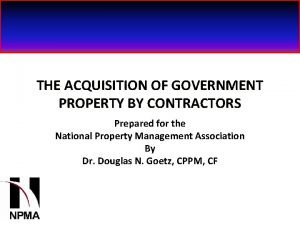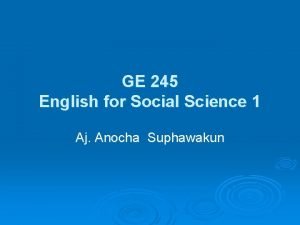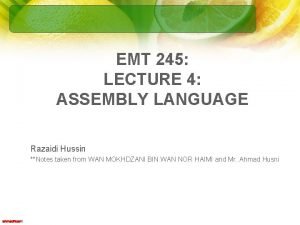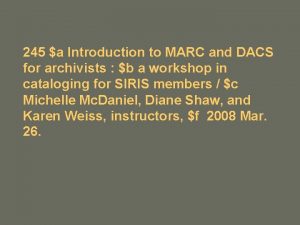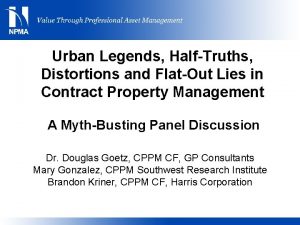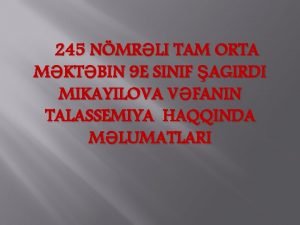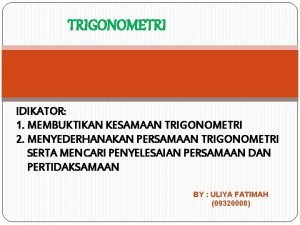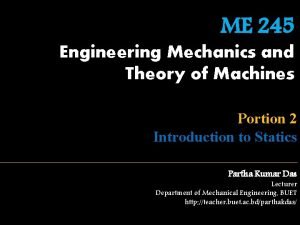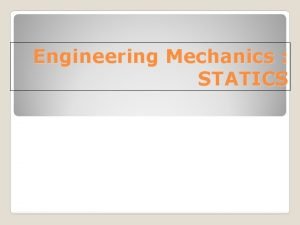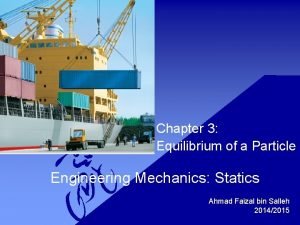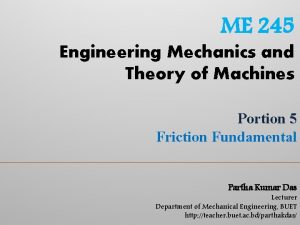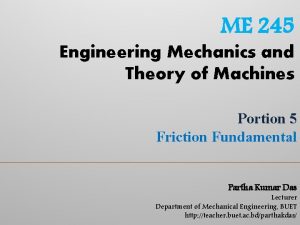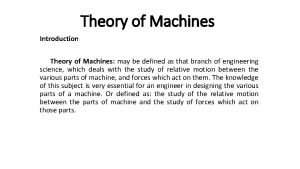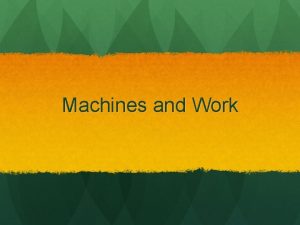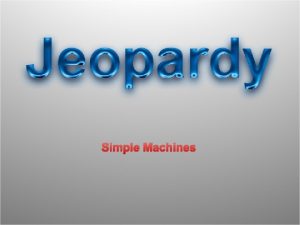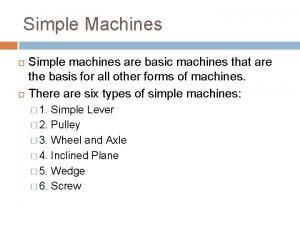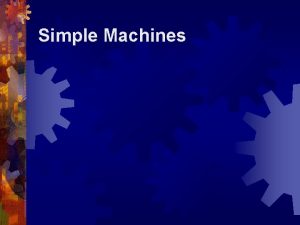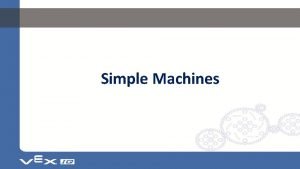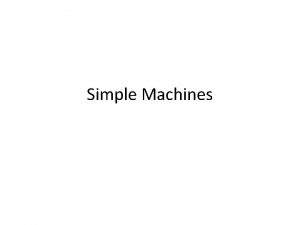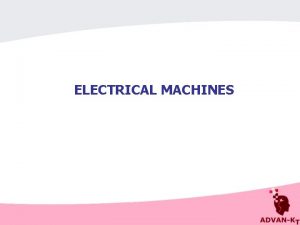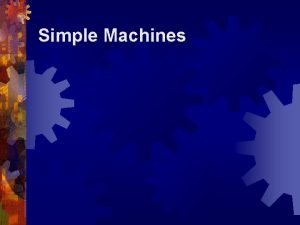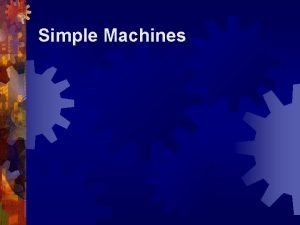ME 245 Engineering Mechanics and Theory of Machines



















- Slides: 19

ME 245 Engineering Mechanics and Theory of Machines Portion 3 Equilibrium Partha Kumar Das Lecturer Department of Mechanical Engineering, BUET http: //teacher. buet. ac. bd/parthakdas/

Condition of Equilibrium Ø Recall Newton’s Second law of Motion. ∑F = ma ∑M = Iα Ø If a rigid body has no acceleration (linear and angular), that is either it’s velocity(linear and angular) is zero (static) or it is moving with a constant velocity(linear and angular), then, ∑F = 0, ∑M = 0 Ø This two equations are known as the condition of equilibrium. Ø If the equations are expanded into their components in axial directions, then, ∑F = ∑Fxi + ∑Fyj + ∑Fzk = 0 ∑Fx = 0 ∑Fy = 0 ∑Fz = 0 ∑M = ∑Mxi + ∑Myj + ∑Mzk = 0 ∑Mx = 0 ∑My = 0 ∑Mz = 0

Equilibrium 2 D Analysis 3 D Analysis

Equilibrium in 2 D Reactions at Supports and Connections

Equilibrium in 2 D Reactions at Supports and Connections

Condition of Equilibrium in 2 D • In 3 D, ∑F = ∑Fxi + ∑Fyj + ∑Fzk = 0 ∑M = ∑Mxi + ∑Myj + ∑Mzk = 0 ∑Fx = 0 ∑Mx = 0 ∑Fy = 0 ∑My = 0 ∑Fz = 0 ∑Mz = 0 • In 2 D, ∑F = ∑Fxi + ∑Fyj = 0 ∑M = ∑Mzk = 0 ∑Fx = 0 , ∑Fy = 0 , ∑Mz = ∑Mo = 0 [o is any point in the x-y plane or plane of the structure] • These three equations are known as the condition of equilibrium in 2 D. • These three equations are Sufficiently Essential to define a structure in equilibrium under any loading condition. The rigid body is then said to be fully or completely constrained. • Modification of these three equations can be possible.

Condition of Equilibrium in 2 D Fully Constrained Partially Constrained Statically Indeterminate Improperly Constrained

Problem 3. 1 (Beer Johnston_10 th edition_P 4. 15) The bracket BCD is hinged at C and attached to a control cable at B. For the loading shown, determine (a) the tension in the cable, (b) the reaction at C. Ans. : Tx = 1600 N , Ty = 1200 N , T = 2 k. N ; C = 2. 32 k. N 46. 4°

Problem 3. 2 (Beer Johnston_10 th edition_P 4. 27) A rod AB hinged at A and attached at B to cable BD supports the loads shown. Knowing that d = 200 mm, determine (a) the tension in cable BD, (b) the reaction at A. Ans. : T = 190. 9 N 45°, A = 142. 3 N 18. 43°

Problem 3. 3 (Beer Johnston_10 th edition_P 4. 21) Determine the reactions at A and C when (a) α = 0°, (b) α = 30°.

Problem 3. 4 A slender rod AB, of weight W = 30 N and length l = 1 m, is attached to blocks A and B, which move freely in the guides shown. The blocks are connected by an elastic cord that passes over a pulley at C. (a) Express the tension in the cord at the moment when θ = 30°. Solution: Steps: 1. Draw the Free Body Diagram of bar AB. Assume tension in the cables are same. 2. Apply three conditions of equilibrium, i. e. + ∑Fx = 0 , + ∑Fy = 0 , + ∑MA = 0 3. Solve three equations. Ans. : T= 35. 491 N

Problem 3. 5 (Beer Johnston_10 th edition_P 4. 10) The maximum allowable value of each of the reactions is 180 N. Neglecting the weight of the beam, determine the range of the distance d for which the beam is safe. Ans. : 150 mm ≤ d ≤ 400 mm

Equilibrium in 3 D Reactions at Supports and Connections

Equilibrium in 3 D Reactions at Supports and Connections

Equilibrium in 3 D Ø Recall Newton’s Second law of Motion. ∑F = ma ∑M = Iα Ø If a rigid body has no acceleration (linear and angular), that is either it’s velocity(linear and angular) is zero (static) or it is moving with a constant velocity(linear and angular), then, ∑F = 0, ∑M = 0 Ø This two equations are known as the condition of equilibrium. Ø If the equations are expanded into their components in axial directions, then, ∑F = ∑Fxi + ∑Fyj + ∑Fzk = 0 ∑M = ∑Mxi + ∑Myj + ∑Mzk = 0

Problem 3. 6 (Beer Johnston_10 th edition_P 4. 91) A 200 -mm lever and a 240 -mm-diameter pulley are welded to the axle BE that is supported by bearings at C and D. If a 720 -N vertical load is applied at A when the lever is horizontal, determine (a) the Tension in the cord, (b) the reactions at C and D. Assume that the bearing at D does not exert any axial thrust. Ans. : T = 1. 2 k. N, C = (0. 4 k. N)i + (1. 2 k. N)j, D= (-1. 6 k. N)i + (-0. 48 k. N)j

Problem 3. 8 (Beer Johnston_10 th edition_P 4. 138) The frame ACD is supported by ball-and-socket joints at A and D and by a cable that passes through a ring at B and is attached to hooks at G and H. Knowing that the frame supports at point C a load of magnitude P = 268 N, determine the tension in the cable. Solution: Steps: 1. Draw the Free Body Diagram of bar ACD. 2. Apply moment equation about AD. ∑MAD = 0 => λAD. (r. AB X TBG)+ λAD. (r. AB X TBH)+ λAD. (r. AC X P )= 0 3. Assume VALUE of tensions ( T ) in the cables are same. Ans. : T = 360 N

End of Portion 3

References ØVector Mechanics for Engineers: Statics and Dynamics Ferdinand Beer, Jr. , E. Russell Johnston, David Mazurek, Phillip Cornwell.
 Simple machines engineering mechanics
Simple machines engineering mechanics General plane motion
General plane motion Engineering elegant systems: theory of systems engineering
Engineering elegant systems: theory of systems engineering Elegant systems
Elegant systems Use a number line to solve 245-137
Use a number line to solve 245-137 245 angle
245 angle 245 prime factors
245 prime factors Dental bur shapes
Dental bur shapes Contractor acquired property
Contractor acquired property Ge 245
Ge 245 Emt 245
Emt 245 200 e yuvarlanan en küçük sayı kaçtır
200 e yuvarlanan en küçük sayı kaçtır Marc 245 example
Marc 245 example What does dcma daco stand for
What does dcma daco stand for 245 nömrəli tam orta məktəb
245 nömrəli tam orta məktəb Menyederhanakan trigonometri
Menyederhanakan trigonometri Meyb-245
Meyb-245 Marc21 245
Marc21 245 Centroid mechanics
Centroid mechanics Particle equilibrium in 2d and 3d engineering mechanics
Particle equilibrium in 2d and 3d engineering mechanics
